Page 28 of 532
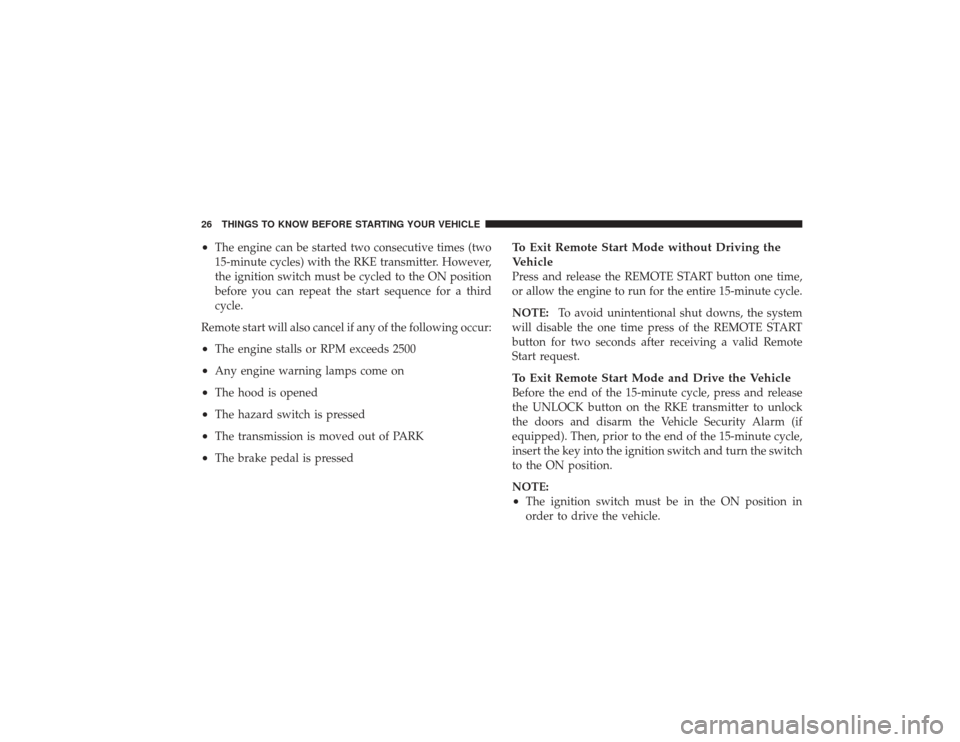
•
The engine can be started two consecutive times (two
15-minute cycles) with the RKE transmitter. However,
the ignition switch must be cycled to the ON position
before you can repeat the start sequence for a third
cycle.
Remote start will also cancel if any of the following occur:
•
The engine stalls or RPM exceeds 2500
•
Any engine warning lamps come on
•
The hood is opened
•
The hazard switch is pressed
•
The transmission is moved out of PARK
•
The brake pedal is pressed
To Exit Remote Start Mode without Driving the
VehiclePress and release the REMOTE START button one time,
or allow the engine to run for the entire 15-minute cycle.
NOTE: To avoid unintentional shut downs, the system
will disable the one time press of the REMOTE START
button for two seconds after receiving a valid Remote
Start request.To Exit Remote Start Mode and Drive the VehicleBefore the end of the 15-minute cycle, press and release
the UNLOCK button on the RKE transmitter to unlock
the doors and disarm the Vehicle Security Alarm (if
equipped). Then, prior to the end of the 15-minute cycle,
insert the key into the ignition switch and turn the switch
to the ON position.
NOTE:•
The ignition switch must be in the ON position in
order to drive the vehicle.
26 THINGS TO KNOW BEFORE STARTING YOUR VEHICLE
Page 29 of 532
DOOR LOCKS
Manual Door LocksFront and rear doors may be locked by moving the lock
plunger up or down.
All doors may be opened with the inside door handle
without lifting the lock plunger. Doors locked before
closing will remain locked when closed.
The ignition key will unlock all the locks on your vehicle.
WARNING!
•
For personal security and safety in the event of an
accident, lock the vehicle doors when you drive as
well as when you park and leave the vehicle.
•
Never leave children alone in a vehicle. Leaving
unattended children in a vehicle is dangerous for a
number of reasons. A child or others could be
seriously or fatally injured. Don’t leave the key in
the ignition. A child could operate power win-
dows, other controls, or move the vehicle.THINGS TO KNOW BEFORE STARTING YOUR VEHICLE 27
2
Page 51 of 532
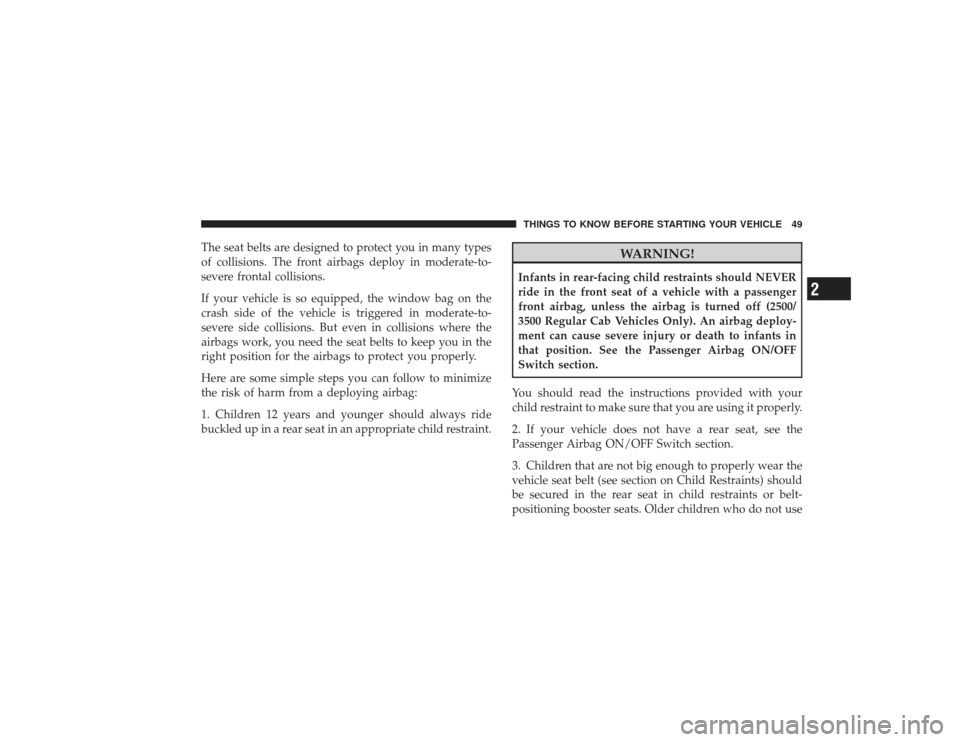
The seat belts are designed to protect you in many types
of collisions. The front airbags deploy in moderate-to-
severe frontal collisions.
If your vehicle is so equipped, the window bag on the
crash side of the vehicle is triggered in moderate-to-
severe side collisions. But even in collisions where the
airbags work, you need the seat belts to keep you in the
right position for the airbags to protect you properly.
Here are some simple steps you can follow to minimize
the risk of harm from a deploying airbag:
1. Children 12 years and younger should always ride
buckled up in a rear seat in an appropriate child restraint.
WARNING!
Infants in rear-facing child restraints should NEVER
ride in the front seat of a vehicle with a passenger
front airbag, unless the airbag is turned off (2500/
3500 Regular Cab Vehicles Only). An airbag deploy-
ment can cause severe injury or death to infants in
that position. See the Passenger Airbag ON/OFF
Switch section.
You should read the instructions provided with your
child restraint to make sure that you are using it properly.
2. If your vehicle does not have a rear seat, see the
Passenger Airbag ON/OFF Switch section.
3. Children that are not big enough to properly wear the
vehicle seat belt (see section on Child Restraints) should
be secured in the rear seat in child restraints or belt-
positioning booster seats. Older children who do not useTHINGS TO KNOW BEFORE STARTING YOUR VEHICLE 49
2
Page 62 of 532
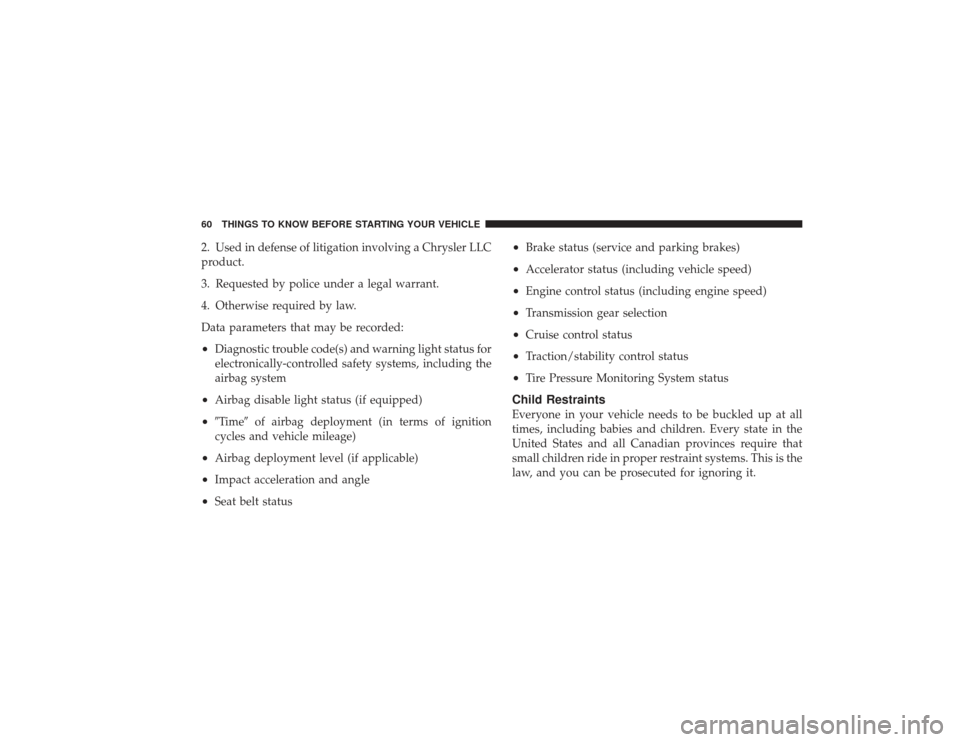
2. Used in defense of litigation involving a Chrysler LLC
product.
3. Requested by police under a legal warrant.
4. Otherwise required by law.
Data parameters that may be recorded:•
Diagnostic trouble code(s) and warning light status for
electronically-controlled safety systems, including the
airbag system
•
Airbag disable light status (if equipped)
•
�Time�of airbag deployment (in terms of ignition
cycles and vehicle mileage)
•
Airbag deployment level (if applicable)
•
Impact acceleration and angle
•
Seat belt status
•
Brake status (service and parking brakes)
•
Accelerator status (including vehicle speed)
•
Engine control status (including engine speed)
•
Transmission gear selection
•
Cruise control status
•
Traction/stability control status
•
Tire Pressure Monitoring System status
Child RestraintsEveryone in your vehicle needs to be buckled up at all
times, including babies and children. Every state in the
United States and all Canadian provinces require that
small children ride in proper restraint systems. This is the
law, and you can be prosecuted for ignoring it.
60 THINGS TO KNOW BEFORE STARTING YOUR VEHICLE
Page 66 of 532
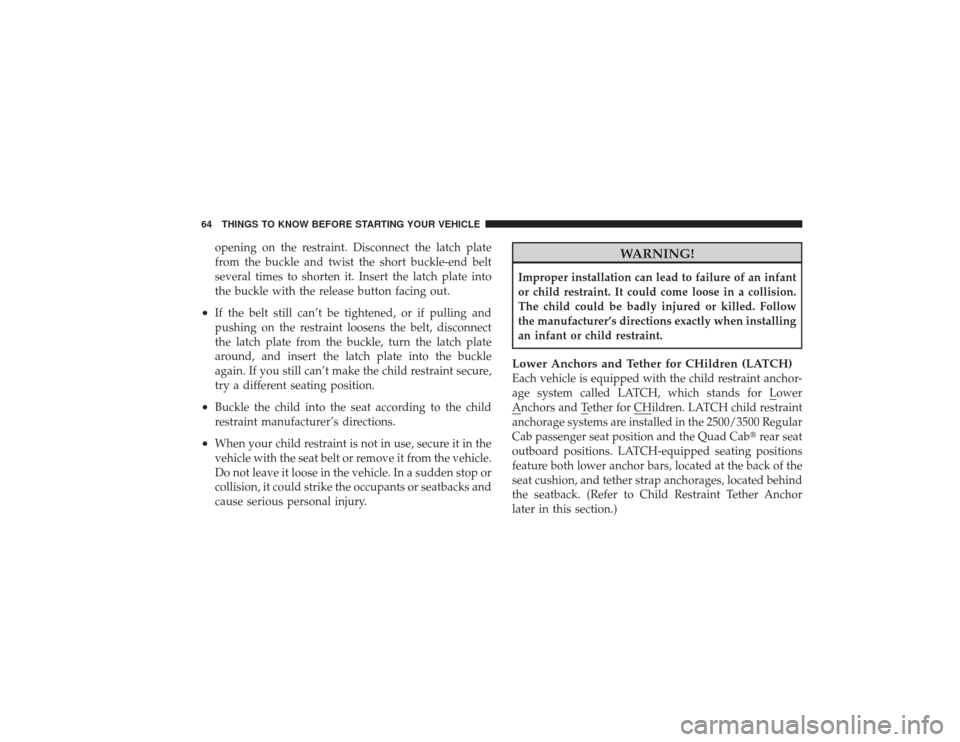
opening on the restraint. Disconnect the latch plate
from the buckle and twist the short buckle-end belt
several times to shorten it. Insert the latch plate into
the buckle with the release button facing out.
•
If the belt still can’t be tightened, or if pulling and
pushing on the restraint loosens the belt, disconnect
the latch plate from the buckle, turn the latch plate
around, and insert the latch plate into the buckle
again. If you still can’t make the child restraint secure,
try a different seating position.
•
Buckle the child into the seat according to the child
restraint manufacturer’s directions.
•
When your child restraint is not in use, secure it in the
vehicle with the seat belt or remove it from the vehicle.
Do not leave it loose in the vehicle. In a sudden stop or
collision, it could strike the occupants or seatbacks and
cause serious personal injury.
WARNING!
Improper installation can lead to failure of an infant
or child restraint. It could come loose in a collision.
The child could be badly injured or killed. Follow
the manufacturer’s directions exactly when installing
an infant or child restraint.Lower Anchors and Tether for CHildren (LATCH)Each vehicle is equipped with the child restraint anchor-
age system called LATCH, which stands for LowerAnchors and Tether for CHildren. LATCH child restraintanchorage systems are installed in the 2500/3500 Regular
Cab passenger seat position and the Quad Cab�rear seat
outboard positions. LATCH-equipped seating positions
feature both lower anchor bars, located at the back of the
seat cushion, and tether strap anchorages, located behind
the seatback. (Refer to Child Restraint Tether Anchor
later in this section.)
64 THINGS TO KNOW BEFORE STARTING YOUR VEHICLE
Page 70 of 532
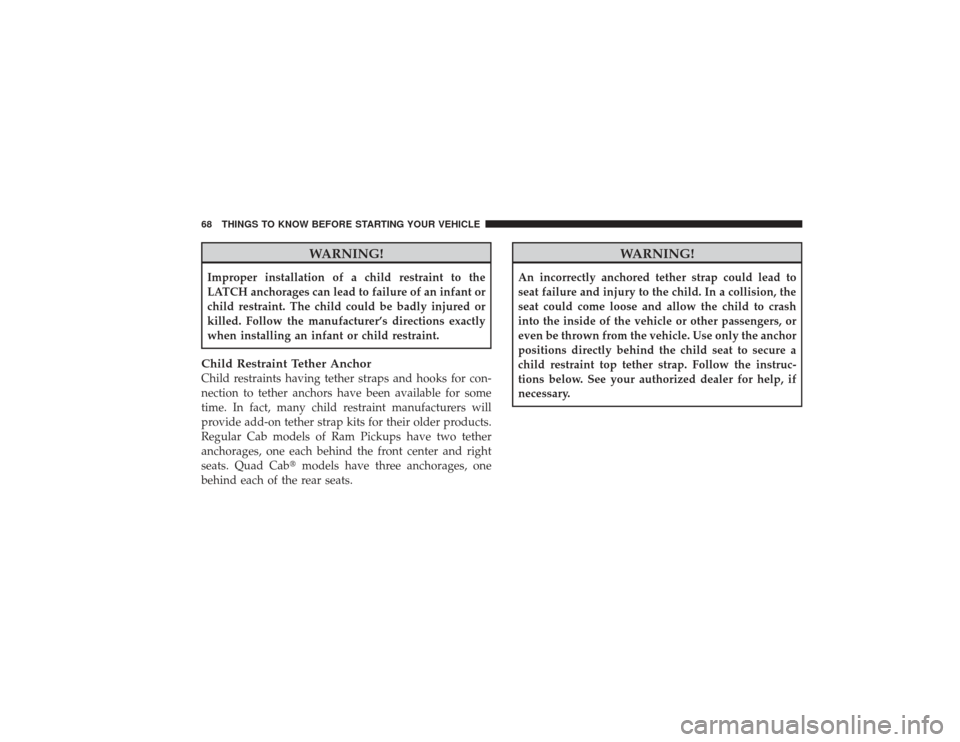
WARNING!
Improper installation of a child restraint to the
LATCH anchorages can lead to failure of an infant or
child restraint. The child could be badly injured or
killed. Follow the manufacturer’s directions exactly
when installing an infant or child restraint.Child Restraint Tether AnchorChild restraints having tether straps and hooks for con-
nection to tether anchors have been available for some
time. In fact, many child restraint manufacturers will
provide add-on tether strap kits for their older products.
Regular Cab models of Ram Pickups have two tether
anchorages, one each behind the front center and right
seats. Quad Cab�models have three anchorages, one
behind each of the rear seats.
WARNING!
An incorrectly anchored tether strap could lead to
seat failure and injury to the child. In a collision, the
seat could come loose and allow the child to crash
into the inside of the vehicle or other passengers, or
even be thrown from the vehicle. Use only the anchor
positions directly behind the child seat to secure a
child restraint top tether strap. Follow the instruc-
tions below. See your authorized dealer for help, if
necessary.
68 THINGS TO KNOW BEFORE STARTING YOUR VEHICLE
Page 75 of 532

Transporting PetsAirbags deploying in the front seat could harm your pet.
An unrestrained pet will be thrown about and possibly
injured, or injure a passenger during panic braking or in
a collision. Pets should be restrained in the rear seat in
pet harnesses or pet carriers that are secured by seat belts.ENGINE BREAK-IN RECOMMENDATIONSA long break-in period is not required for the engine in
your vehicle.
Drive moderately during the first 300 miles (500 km).
After the initial 60 miles (100 km), speeds up to 50 or
55 mph (80 or 90 km/h) are desirable.
While cruising, brief full-throttle acceleration within the
limits of local traffic laws, contributes to a good break-in.
Wide-open throttle acceleration in low gear can be detri-
mental and should be avoided.The engine oil installed in the engine at the factory is a
high-quality energy conserving type lubricant. Oil
changes should be consistent with anticipated climate
conditions under which vehicle operations will occur.
The recommended viscosity and quality grades are
shown in “Engine Oil”, under “Maintenance Procedures”
in section 7 of this manual. NON-DETERGENT OR
STRAIGHT MINERAL OILS MUST NEVER BE USED.
A new engine may consume some oil during its first few
thousand miles (kilometers) of operation. This should be
considered a normal part of the break-in and not inter-
preted as an indication of difficulty.
THINGS TO KNOW BEFORE STARTING YOUR VEHICLE 73
2
Page 82 of 532
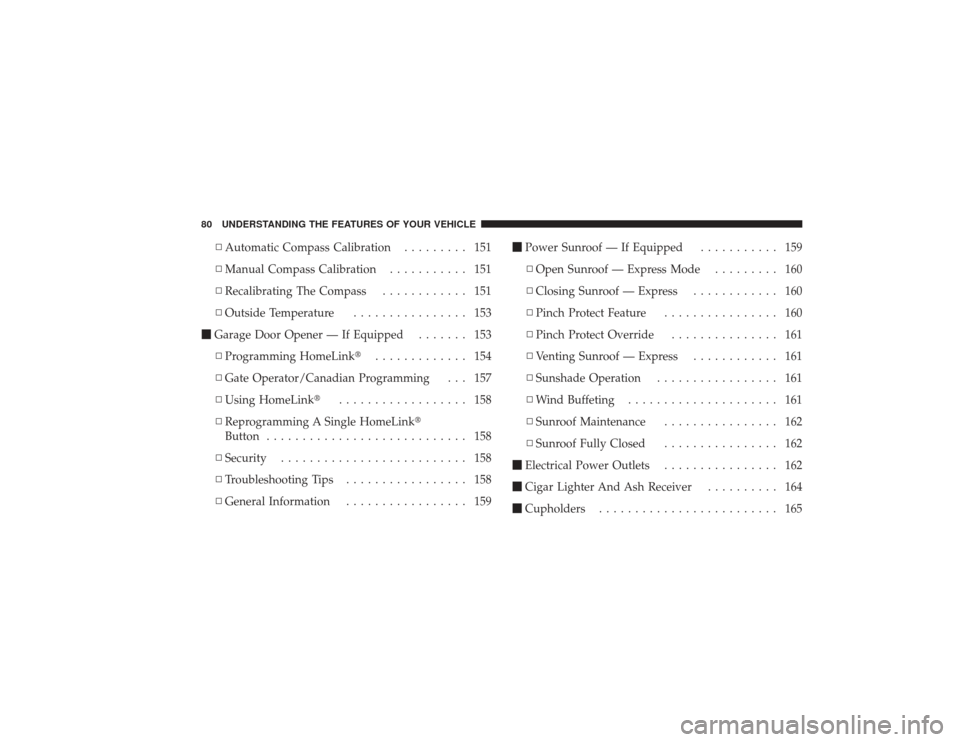
▫Automatic Compass Calibration ......... 151
▫ Manual Compass Calibration ........... 151
▫ Recalibrating The Compass ............ 151
▫ Outside Temperature ................ 153
� Garage Door Opener — If Equipped ....... 153
▫ Programming HomeLink� ............. 154
▫ Gate Operator/Canadian Programming . . . 157
▫ Using HomeLink� .................. 158
▫ Reprogramming A Single HomeLink�
Button ............................ 158
▫ Security .......................... 158
▫ Troubleshooting Tips ................. 158
▫ General Information ................. 159 �
Power Sunroof — If Equipped ........... 159
▫ Open Sunroof — Express Mode ......... 160
▫ Closing Sunroof — Express ............ 160
▫ Pinch Protect Feature ................ 160
▫ Pinch Protect Override ............... 161
▫ Venting Sunroof — Express ............ 161
▫ Sunshade Operation ................. 161
▫ Wind Buffeting ..................... 161
▫ Sunroof Maintenance ................ 162
▫ Sunroof Fully Closed ................ 162
� Electrical Power Outlets ................ 162
� Cigar Lighter And Ash Receiver .......... 164
� Cupholders ......................... 165
80 UNDERSTANDING THE FEATURES OF YOUR VEHICLE